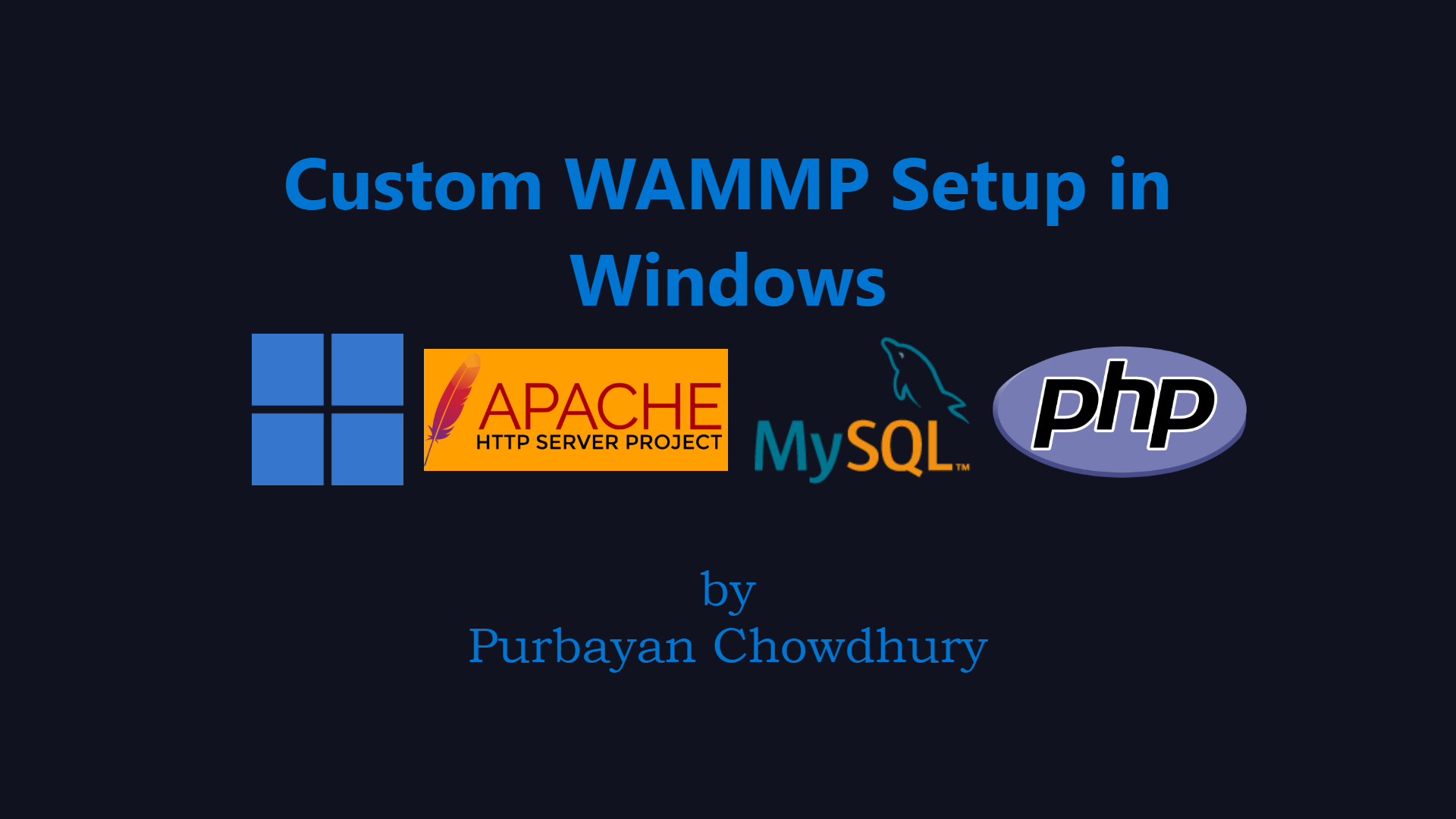
Custom WAMMP Setup in Windows (mod_wsgi support)
Are you tired of using pre-packaged WAMPP solutions that limit your control and flexibility? Do you need to run Python web applications on Windows using the Apache web server? Look no further! This guide will walk you through the process of setting up a custom WAMPP environment on Windows, complete with mod_wsgi support for running Python web applications.
By following this guide, you’ll learn how to:
- Install and configure Apache, MySQL, and PHP/Python on Windows
- Set up mod_wsgi to run Python web applications using Apache
- Configure your custom WAMPP environment to meet your specific needs
- Troubleshoot common issues and optimize performance
Whether you’re a developer, system administrator, or simply looking for a more customizable WAMPP solution, this guide has got you covered. Let’s get started!
Php installation
- Download
php-8.1.*-Win32-vs16-x64.zipfile from https://windows.php.net/download#php-8.1 - Unzip and rename the folder to
php81and place it inC:\Apps
or
- Set
ChocolateyToolsLocationtoC:\Apps -
Install php using choco
choco install php --version=8.1.22 --package-parameters='"/ThreadSafe"' choco install php --version=8.2.15 --package-parameters='"/ThreadSafe"' -
Set extension directory
extension_dir = "ext" - Copy
C:\Apps\php81\php.ini-productionintoC:\Apps\php81\php.ini -
Enable the extensions by commenting following lines
extension=curl extension=ftp extension=fileinfo extension=gd extension=gettext extension=mbstring extension=exif ; Must be after mbstring as it depends on it extension=mysqli extension=openssl extension=pdo_mysql extension=pdo_sqlite extension=soap extension=xsl
Download ca certificate and replace for curl config
- Download the cacert.pem from https://curl.se/ca/cacert.pem.
-
Move it to
C:/Apps/php81/extras/ssland add uncomment the below line inphp.ini.curl.cainfo = "C:\Apps\php81\extras\ssl\cacert.pem"
Apache server installation
- Download
httpd-2.4.*-win64-VS17.zipfrom https://www.apachelounge.com/download/. - Unzip the above zip file and move
Apache24toC:\Apps\Apache24.
Go to directory and install as service
- Open the terminal in administrative mode and run the below commands
cd C:\Apache24\bin\
httpd -k install
- httpd server will be installed and
Apache2.4should be available in Services.
Configuring in httpd server
-
Prepare a
httpd-php.conffile with following content inC:\Apps\Apache24\conf\extra# # PHP-Module setup # LoadFile "C:/Apps/php81/php8ts.dll" LoadFile "C:/Apps/php81/libpq.dll" LoadFile "C:/Apps/php81/libsqlite3.dll" LoadModule php_module "C:/Apps/php81/php8apache2_4.dll" <FilesMatch "\.php$"> SetHandler application/x-httpd-php </FilesMatch> <FilesMatch "\.phps$"> SetHandler application/x-httpd-php-source </FilesMatch> <IfModule php_module> PHPINIDir "C:/Apps/php8" </IfModule> <IfModule mime_module> AddType text/html .php .phps </IfModule> ScriptAlias /php-cgi/ "C:/Apps/php8/" <Directory "C:/Apps/php8"> AllowOverride None Options None Require all denied <Files "php-cgi.exe"> Require all granted </Files> </Directory> -
Include the above file in
C:\Apps\Apache24\conf\httpd.conf.Include conf/extra/httpd-php.conf
MySQL installation
-
Download .msi file from https://dev.mysql.com/downloads/installer/ and install
-
Set the
rootpassword
phpMyAdmin
- Download zip phpmyadmin - https://files.phpmyadmin.net/phpMyAdmin/5.2.1/phpMyAdmin-5.2.1-all-languages.zip
- Unzip and copy the
phpmyadminfolder intoC:/Apache24/htdocs - Create a phpmyadmin user
pma - Edit config in
C:\Apache24\htdocs\phpmyadmin\config.inc.php(Copy fromconfig.sample.inc.php)
/* Authentication type and info */
$cfg['Servers'][$i]['auth_type'] = 'config';
$cfg['Servers'][$i]['user'] = 'root';
$cfg['Servers'][$i]['password'] = '<mysql_password>';
$cfg['Servers'][$i]['extension'] = 'mysqli';
$cfg['Servers'][$i]['AllowNoPassword'] = false;
$cfg['Lang'] = 'en';
/* User for advanced features */
$cfg['Servers'][$i]['controluser'] = 'pma';
$cfg['Servers'][$i]['controlpass'] = '<control_password>';
Adding Xdebug for code coverage
- Download xdebug file from https://xdebug.org/files/php_xdebug-3.3.0alpha2-8.1-vs16-x86_64.dll
- Move it to
Apps\php81\extand rename it tophp_xdebug.dll. - Update
C:\Apps\php81\php.iniand add the line:
zend_extension=xdebug
Configuring Virtual Hosts and Symbolic Links
- Create a symbolic directory from project directory
mklink /D C:\Apache24\htdocs\diybaazar C:\Users\purch\Documents\Projects\Github\DIY-Baazar\diybaazar-main
mklink /D C:\Apache24\htdocs\diybaazar-admin C:\Users\purch\Documents\Projects\Github\DIY-Baazar\diybaazar-admin
mklink /D C:\Apache24\htdocs\diybdocs C:\Users\purch\Documents\Projects\Github\DIY-Baazar\diybaazar-docs
- Add virtual host config in
httpd-vhosts.conf
<VirtualHost *:80>
ServerAdmin webmaster@localhost
</VirtualHost>
<VirtualHost *:80>
ServerAdmin webmaster@diybaazar.xyz
DocumentRoot "${SRVROOT}/htdocs/diybaazar"
ServerName diybaazar.xyz
ErrorLog "logs/diybaazar.xyz-error.log"
CustomLog "logs/diybaazar.xyz-access.log" common
</VirtualHost>
Hosting Flask Service
- Installing mod-wsgi
pip install mod-wsgi
- Run the following the command and copy the output
mod_wsgi-express module-config
Output will look something like this:
LoadFile "C:/Python311/python311.dll"
LoadModule wsgi_module "C:/Python311/Lib/site-packages/mod_wsgi/server/mod_wsgi.cp311-win_amd64.pyd"
WSGIPythonHome "C:/Python311"
-
Paste it in
httpd.conf. -
Add the following config in
httpd-vhosts.conf.
<VirtualHost *:80>
DocumentRoot "${SRVROOT}/htdocs/diybdocs"
ServerAdmin webmaster@diybaazar.xyz
ServerName docs.diybaazar.xyz
WSGIScriptAlias / "${SRVROOT}/htdocs/diybdocs/app.wsgi"
<Directory "${SRVROOT}/htdocs/diybdocs">
WSGIApplicationGroup %{GLOBAL}
WSGIScriptReloading On
allow from all
#Options None
AllowOverride All
Require all granted
</Directory>
ErrorLog "logs/docs.diybaazar.xyz-error.log"
CustomLog "logs/docs.diybaazar.xyz-access.log" common
</VirtualHost>